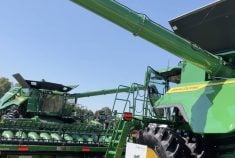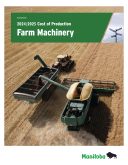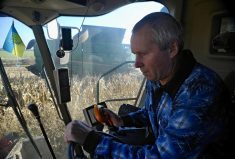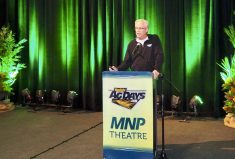Farmer reaction to herbicide-resistant weeds may trend towards, “kill it with fire,” but the latest harvest tool out of Redekop Manufacturing has a different answer for weed seeds: pound them to oblivion.
The Saskatoon-based manufacturer recently unveiled its seed control unit, compatible with John Deere combines.
With resistant weed pressure and certain herbicides increasingly in the public crosshairs, the industry is looking for more tools in the weed control tool box.
The unit, which connects either to Redekop’s MAV straw chopper or John Deere’s factory option, separates straw and chaff and directs the chaff stream through two mills made up of three stationary and three rotating rings of steel bars.
Read Also

Your best (and easiest) holiday dainty tray
Make-ahead recipes, store-bought goodies and co-operation with friends and family: Here’s how to throw together a stunning, low-stress tray.
“As those rings rotate, it pushes the chaff and the weeds up against the other bars… at a high velocity and when they come out the back, they’re dead,” Redekop Manufacturing owner Trevor Thiessen said.
Farmers can expect to destroy over 98 per cent of weed seeds that run through the combine with the unit, the company’s promotional materials claim.
Chaff is then remixed with straw and spread behind the combine in a width equal to the cutting length. The company says the design minimizes dust and more equally spreads residue.
The unit launched during this year’s Ag in Motion digital farm show, where it won the Innovations Program award for agricultural equipment.
The seed control unit was one of four products to receive such award. The farm show annually recognizes innovations for equipment, animal and livestock, agribusiness services and plant and soil.
In this case, show director Rob O’Connor said, judges singled out the seed control unit for its potential in non-chemical weed control.
The ability to beat back weeds without spray has got more and more attention in recent years with the increasing public debate on certain chemistries, O’Connor noted.
“I think everybody recognized how important it is to look for other solutions to managing weeds in the fields,” he said.
Judges particularly liked the mechanical nature of this avenue of weed control, O’Connor noted.
Thiessen also pointed to the growing number of farmers fighting herbicide-resistant weeds.
Provincial weed experts have previously estimated at least 34 herbicide-resistant weeds are lurking in Manitoba fields, a number they admit is likely downplayed.
Wild oats, for example, have developed a worrying tendency towards both Group 1 and Group 2 resistance, while glyphosate-resistant kochia has been a slowly creeping threat throughout much of the province. In 2018, a survey from the province found that 59 per cent of the 297 kochia samples gathered were resistant to some kind of herbicide, compared to one per cent in a similar survey in 2013.
“Fifteen, 20 years ago, we probably wouldn’t have even been having this conversation about resistant weeds,” Thiessen said, “but it continues to grow and chemistries aren’t necessarily going to be able to keep up or give all of the solutions that a farmer needs, so then they have to look at rotation or they have to look at tillage, and now one of the tools is this whole concept of using harvest tools, or harvest weed seed control.”
In general, he noted, harvest weed seed control involves gathering chaff off the back of the combine and “doing something with it.”
“You can burn it or you can bale it and ship it off to someone else or, in the case of our product, you mill it and basically pulverize the weeds and any of the seeds,” he said.
Requirements and caveats
The Redekop system only works for harvestable weed seeds, Thiessen cautioned. Seeds that are too close to the ground will not be impacted, nor will weeds that already dropped seed prior to harvest.
“A good example of that would be wild oats,” he said, noting that a significant portion of wild oats have already seeded themselves by the time crops in Western Canada are mature.
Power draw is another variable. Class seven to nine combines will likely operate the unit with little trouble, Thiessen said, although the system will likely not work with much older or smaller machines.
“It’s loud. It will take some more horsepower, so there is going to be some noticeable impact to your overall combine performance, but we’ve tested on a wide range of models and horsepower ranges and you can still basically do your normal harvest operation with minimal impact,” he said.
The system requires about 35 horsepower, “running empty,” and about 65 horsepower under normal yield conditions, according to Thiessen.
The company has also pointed to the system’s “easy on/easy off” capability, which it says should allow a producer to easily switch the unit off, should a field be particularly clean.
The seed control unit is currently limited to John Deere, although Thiessen says his company is currently in discussion with other brands.
“Our initial goal was to get the system right and just pick one brand to get that system right,” he said. “We took our time to make sure that was sorted out. We’ll have a couple of different brands in testing this year.”
Case and New Holland will likely be of most interest to Manitoba farmers, he noted, while Lexion and AGCO options are also in development.
















